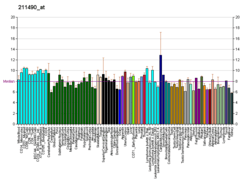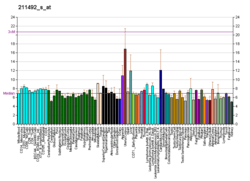Alpha-1A adrenergic receptor
The alpha-1A adrenergic receptor (α1A adrenoreceptor), also known as ADRA1A, formerly known also as the alpha-1C adrenergic receptor,[3] is an alpha-1 adrenergic receptor, and also denotes the human gene encoding it.[4] There is no longer a subtype α1C receptor. At one time, there was a subtype known as α1C, but it was found to be identical to the previously discovered α1A receptor subtype. To avoid confusion, the naming convention was continued with the letter D.
Receptor
There are 3 alpha-1 adrenergic receptor subtypes: alpha-1A, -1B and -1D, all of which signal through the Gq/11 family of G-proteins. Different subtypes show different patterns of activation. The majority of alpha-1 receptors are directed toward the function of epinephrine, a hormone that has to do with the fight-or-flight response.
Gene
This gene encodes the alpha-1A-adrenergic receptor. Alternative splicing of this gene generates four transcript variants, which encode four different isoforms with distinct C-termini but having similar ligand binding properties.[4]
Ligands
Agonists
- 6-(5-fluoro-2-pyrimidin-5-yl-phenyl)-6,7-dihydro-5H-pyrrolo[1,2-a]imidazole: EC50 = 1nM, Emax = 65%; good selectivity over α1B, α1D and α2A subtypes[5]
- further partial agonistic imidazole compounds[6][7]
- A-61603[8]
Antagonists
- Tamsulosin: for treatment of benign prostatic hyperplasia
- Silodosin: for treatment of benign prostatic hyperplasia
- Risperidone
- WB-4101
- Ziprasidone
Role in neural circuits
α1A-adrenergic receptor subtypes increase inhibition at dendrodendritic synapses, suggesting a synaptic mechanism for noradrenergic modulation of olfactory driven behaviors.[9]
See also
References
- ↑ "Human PubMed Reference:".
- ↑ "Mouse PubMed Reference:".
- ↑ Langer SZ (1998). "Nomenclature and state of the art on alpha1-adrenoceptors". Eur. Urol. 33 Suppl 2: 2–6. PMID 9556189. doi:10.1159/000052227.
- 1 2 "Entrez Gene: ADRA1A adrenergic, alpha-1A-, receptor".
- ↑ Roberts LR, Fish PV, Ian Storer R, Whitlock GA (April 2009). "6,7-Dihydro-5H-pyrrolo[1,2-a] imidazoles as potent and selective alpha(1A) adrenoceptor partial agonists". Bioorg. Med. Chem. Lett. 19 (11): 3113–7. PMID 19414260. doi:10.1016/j.bmcl.2009.03.166.
- ↑ Whitlock GA, Brennan PE, Roberts LR, Stobie A (April 2009). "Potent and selective alpha(1A) adrenoceptor partial agonists-Novel imidazole frameworks". Bioorg. Med. Chem. Lett. 19 (11): 3118–21. PMID 19394220. doi:10.1016/j.bmcl.2009.03.162.
- ↑ Roberts LR, Bryans J, Conlon K, McMurray G, Stobie A, Whitlock GA (December 2008). "Novel 2-imidazoles as potent, selective and CNS penetrant alpha1A adrenoceptor partial agonists". Bioorg. Med. Chem. Lett. 18 (24): 6437–40. PMID 18980842. doi:10.1016/j.bmcl.2008.10.066.
- ↑ Knepper SM, Buckner SA, Brune ME, DeBernardis JF, Meyer MD, Hancock AA (1995). "A-61603, a potent alpha 1-adrenergic receptor agonist, selective for the alpha 1A receptor subtype". J. Pharmacol. Exp. Ther. 274 (1): 97–103. PMID 7616455.
- ↑ Zimnik NC, Treadway T, Smith RS, Araneda RC (2013). "α(1A)-Adrenergic regulation of inhibition in the olfactory bulb". J. Physiol. (Lond.). 591 (Pt 7): 1631–43. PMC 3624843
 . PMID 23266935. doi:10.1113/jphysiol.2012.248591.
. PMID 23266935. doi:10.1113/jphysiol.2012.248591.
External links
- "α1A-adrenoceptor". IUPHAR Database of Receptors and Ion Channels. International Union of Basic and Clinical Pharmacology.
- Human ADRA1A genome location and ADRA1A gene details page in the UCSC Genome Browser.
Further reading
- Mátyus P, Horváth K (1998). "Alpha-adrenergic approach in the medical management of benign prostatic hyperplasia". Med Res Rev. 17 (6): 523–35. PMID 9359081. doi:10.1002/(SICI)1098-1128(199711)17:6<523::AID-MED2>3.0.CO;2-3.
- Hoehe MR, Berrettini WH, Schwinn DA, Hsieh WT (1993). "A two-allele PstI RFLP for the alpha-1C adrenergic receptor gene (ADRA1C)". Hum. Mol. Genet. 1 (5): 349. PMID 1363873. doi:10.1093/hmg/1.5.349-a.
- Schwinn DA, Lomasney JW, Lorenz W, et al. (1990). "Molecular cloning and expression of the cDNA for a novel alpha 1-adrenergic receptor subtype". J. Biol. Chem. 265 (14): 8183–9. PMID 1970822.
- Hirasawa A, Shibata K, Horie K, et al. (1995). "Cloning, functional expression and tissue distribution of human alpha 1c-adrenoceptor splice variants". FEBS Lett. 363 (3): 256–60. PMID 7737411. doi:10.1016/0014-5793(95)00330-C.
- Diehl NL, Shreeve SM (1995). "Identification of the alpha 1c-adrenoceptor in rabbit arteries and the human saphenous vein using the polymerase chain reaction". Eur. J. Pharmacol. 268 (3): 393–8. PMID 7805763. doi:10.1016/0922-4106(94)90064-7.
- Schwinn DA, Johnston GI, Page SO, et al. (1995). "Cloning and pharmacological characterization of human alpha-1 adrenergic receptors: sequence corrections and direct comparison with other species homologues". J. Pharmacol. Exp. Ther. 272 (1): 134–42. PMID 7815325.
- Weinberg DH, Trivedi P, Tan CP, et al. (1994). "Cloning, expression and characterization of human alpha adrenergic receptors alpha 1a, alpha 1b and alpha 1c". Biochem. Biophys. Res. Commun. 201 (3): 1296–304. PMID 8024574. doi:10.1006/bbrc.1994.1845.
- Forray C, Bard JA, Wetzel JM, et al. (1994). "The alpha 1-adrenergic receptor that mediates smooth muscle contraction in human prostate has the pharmacological properties of the cloned human alpha 1c subtype". Mol. Pharmacol. 45 (4): 703–8. PMID 8183249.
- Hirasawa A, Horie K, Tanaka T, et al. (1993). "Cloning, functional expression and tissue distribution of human cDNA for the alpha 1C-adrenergic receptor". Biochem. Biophys. Res. Commun. 195 (2): 902–9. PMID 8396931. doi:10.1006/bbrc.1993.2130.
- Tseng-Crank J, Kost T, Goetz A, et al. (1996). "The alpha 1C-adrenoceptor in human prostate: cloning, functional expression, and localization to specific prostatic cell types". Br. J. Pharmacol. 115 (8): 1475–85. PMC 1908895
 . PMID 8564208. doi:10.1111/j.1476-5381.1995.tb16640.x.
. PMID 8564208. doi:10.1111/j.1476-5381.1995.tb16640.x. - Shibata K, Hirasawa A, Moriyama N, et al. (1997). "Alpha 1a-adrenoceptor polymorphism: pharmacological characterization and association with benign prostatic hypertrophy". Br. J. Pharmacol. 118 (6): 1403–8. PMC 1909672
 . PMID 8832064. doi:10.1111/j.1476-5381.1996.tb15552.x.
. PMID 8832064. doi:10.1111/j.1476-5381.1996.tb15552.x. - Chang DJ, Chang TK, Yamanishi SS, et al. (1998). "Molecular cloning, genomic characterization and expression of novel human alpha1A-adrenoceptor isoforms". FEBS Lett. 422 (2): 279–83. PMID 9490024. doi:10.1016/S0014-5793(98)00024-6.
- Daniels DV, Gever JR, Jasper JR, et al. (1999). "Human cloned alpha1A-adrenoceptor isoforms display alpha1L-adrenoceptor pharmacology in functional studies". Eur. J. Pharmacol. 370 (3): 337–43. PMID 10334511. doi:10.1016/S0014-2999(99)00154-5.
- Cogé F, Guenin SP, Renouard-Try A, et al. (1999). "Truncated isoforms inhibit 3Hprazosin binding and cellular trafficking of native human alpha1A-adrenoceptors". Biochem. J. 343 Pt 1 (Pt 1): 231–9. PMC 1220546
 . PMID 10493934. doi:10.1042/0264-6021:3430231.
. PMID 10493934. doi:10.1042/0264-6021:3430231. - Rudner XL, Berkowitz DE, Booth JV, et al. (1999). "Subtype specific regulation of human vascular alpha(1)-adrenergic receptors by vessel bed and age". Circulation. 100 (23): 2336–43. PMID 10587338. doi:10.1161/01.cir.100.23.2336.
- Ballou LM, Cross ME, Huang S, et al. (2000). "Differential regulation of the phosphatidylinositol 3-kinase/Akt and p70 S6 kinase pathways by the alpha(1A)-adrenergic receptor in rat-1 fibroblasts". J. Biol. Chem. 275 (7): 4803–9. PMID 10671514. doi:10.1074/jbc.275.7.4803.
- Keffel S, Alexandrov A, Goepel M, Michel MC (2000). "alpha(1)-adrenoceptor subtypes differentially couple to growth promotion and inhibition in Chinese hamster ovary cells". Biochem. Biophys. Res. Commun. 272 (3): 906–11. PMID 10860850. doi:10.1006/bbrc.2000.2850.
- Richman JG, Brady AE, Wang Q, et al. (2001). "Agonist-regulated Interaction between alpha2-adrenergic receptors and spinophilin". J. Biol. Chem. 276 (18): 15003–8. PMID 11154706. doi:10.1074/jbc.M011679200.
- Shibata K, Katsuma S, Koshimizu T, et al. (2003). "alpha 1-Adrenergic receptor subtypes differentially control the cell cycle of transfected CHO cells through a cAMP-dependent mechanism involving p27Kip1". J. Biol. Chem. 278 (1): 672–8. PMID 12409310. doi:10.1074/jbc.M201375200.


